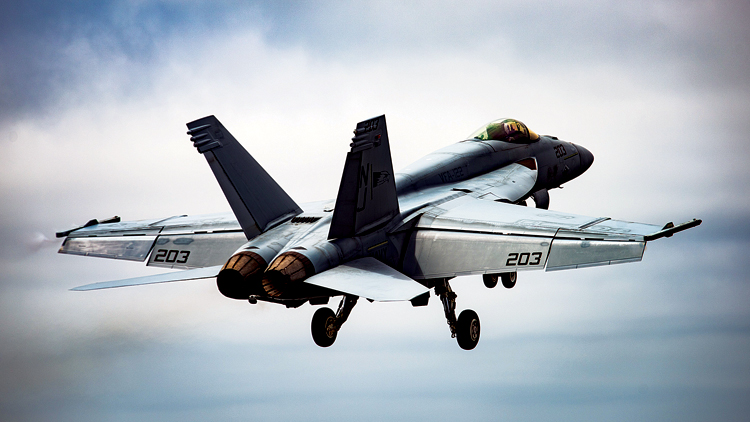INDIAN ARMED FORCES CHIEFS ON
OUR RELENTLESS AND FOCUSED PUBLISHING EFFORTS

SP Guide Publications puts forth a well compiled articulation of issues, pursuits and accomplishments of the Indian Army, over the years

I am confident that SP Guide Publications would continue to inform, inspire and influence.

My compliments to SP Guide Publications for informative and credible reportage on contemporary aerospace issues over the past six decades.
Endless Possibilities
Boeing is not just offering unmatched products to the Indian armed forces but also significant benefits to India’s indigenous aerospace manufacturing sector
 | By Gene Cunningham Vice President, Global Sales, Boeing Defense, Space & Security |
The importance of carrier aviation cannot be understated – in particular to a country like India with a large coastline covering more than half its borders. The Indian Air Force (IAF) is focused on protecting the north, and with coastlines covering much of India’s east – south – and west, the need for a strong carrier air wing is clear. With multi-role capabilities, advanced technologies with room to grow and low acquisition and sustainment costs, the F/A-18 Super Hornet is the clear choice for India. With designed-in stealth, an AESA radar and many other advanced technologies that are ideal for mission requirements of the naval aviator, the F/A-18 Super Hornet is the most advanced aircraft of its kind in operation today and will provide operational benefits to the existing and future force structure of the Indian armed forces.
Boeing’s Super Hornet offers the best of those attributes – it is combat proven, but defined to meet the US Navy’s flight plan so that it continues to evolve to outpace future threats. The Super Hornet will be on the Navy’s carrier decks well into the 2040s – being three-fourths of the Navy’s strike fighter capacity into the 2030’s and no less than half the carriers striking force into the 2040’s.
Introduced in 2007, the F/A-18 Super Hornet Block II is the world’s preeminent carrier capable aircraft and best suited for India’s naval fighter requirements. The F/A-18 Super Hornet was designed from day one for carrier operations and is the world’s preeminent carrier capable aircraft. Every Super Hornet to the US Navy has been delivered on cost and on schedule.
Every Super Hornet has a buddy refueling capability that can extend time on station, range, and endurance. Additionally, the Super Hornet can provide close and deep air support through the active electronically scanned array (AESA) radar targeting data and reliable data links. The Super Hornets are fully compatible with the Indian Navy’s aircraft carriers. Extensive simulation has shown that the Super Hornet is capable of conducting STOBAR operations with a meaningful weapons and fuel load.
Ease of Maintenance
The F/A-18 Super Hornet not only has a low acquisition cost, but it costs less per flight hour to operate than any other tactical aircraft in US forces inventory. Part of its affordability is because the Super Hornet is designed to need far less maintenance; this translates into high mission availability. Plus, the Super Hornet does not require any scheduled depot-level maintenance and the engine does not require any scheduled maintenance between overhauls.
This low cost of operation, low maintenance requirements and twin-engine based survivability allow the Super Hornet to fly to and back from harsh environments.
Prepared for future threats: F/A-18 Advanced Super Hornet Capabilities
Every two years Boeing and its industry partners along with the US Navy work on delivering new capabilities to the fighter. Critical mission systems such as the radar, mission computers and sensors continue to evolve to match up to the mission profiles of the future.
To address the capabilities needed in the air wing as early as the 2020s, Boeing has also developed the Block III Super Hornet to complement existing and future air wing capabilities. Block III is the same aircraft as Advanced Super Hornet. The Advanced F/A-18E/F Super Hornet’s multi-mission capabilities include battle-space situational awareness, counter stealth targeting, greater range and increased acceleration, improved survivability and reduced signature and room for growth.
These advanced capabilities can be both built into new aircraft and incorporated into existing aircraft, allowing maximum ability to field these capabilities quickly and affordably. Block III Super Hornet is built from the same airframe as Block II, providing low risk development and maintaining the lowest operating costs of any US tactical fighter. While Boeing demonstrated advanced Super Hornet capabilities in flight in 2013, the package of upgrades has evolved to best complement F-35, EA-18G and E-2D as they will be operating together in the air wing well into the 2040s.
Key features of Block III Super Hornet include enhanced network capability, longer range with low-drag, stealthy conformal fuel tanks, long-range detection with Infrared Search & Track, enhanced situational awareness with a new Advanced Cockpit System, improved signature with low observable next generation radar cross section for increased survivability and 9,000+ hour life for reduced life cycle costs by incorporating design changes into production aircraft based on lessons learned from the Service Life Analysis Program.
A significant design evolution is the addition of Conformal Fuel Tanks. Mounted on the shoulder of the Block III, conformal fuel tanks extend the range of the Block III by 100 nautical miles which is significantly larger range when compared to the Block II. Conformal Fuel Tanks also free up the space occupied by a centerline drop-tank. This means that the Air Force and the Navy have an additional hard-point to carry more air-to-air or air-to-ground weapons.
Modern and next-generation aircraft have a large amount of data available through their sensors. The Super Hornet Block III comes equipped with Distributing Targeting Processor Network (DTP-N) and Tactical Targeting Network Technology (TTNT). These are basically a computer and a big data platform that work together to aid in even more efficient movement and management of data within assets.
The Advanced Cockpit System is a next-generation use interface, which simplifies the interpretation and projection of a large quantity of information for the aircrew – both in the front and rear cockpit – making it easy to interface and manage an information network. The Block IIIs sensors along with the APG-79 AESA Radar coupled to DTP-N and TTNT systems plots information on the Advances Cockpit System making it easy for aircrews to view and manage information.
Even though the Super Hornet Block II is a stealth aircraft, Boeing has made a few signature improvements to reduce the Radar Cross Section (RCS) of the Block III to make it even stealthier.
F/A-18 Super Hornet Make in India
Boeing has had a presence in India for more than seven decades and is committed to expanding that partnership by producing Super Hornets in India, further developing India’s aerospace ecosystem. Boeing’s proposed ‘Make in India’ plans for the Super Hornet are not about moving a production line but rather building an entirely new and stateof-the-art production facility that can be utilized for other programmes like India’s advanced medium combat aircraft (AMCA) programme.
Boeing is prepared to bring its global scale and supply chain, its best-in-industry precision manufacturing processes, as well as the company’s unrivaled experience designing and optimising aerospace production facilities to bear in both expanding India’s aerospace ecosystem and helping realise the ‘Make in India’ vision. The approach addresses the infrastructure, personnel training, and operational tools and techniques required to produce a next gen fighter aircraft right here in India.

Boeing will work closely with India industry to ensure they have the very latest technologies, applying lessons learned from the current Super Hornet production line. The programme envisages transitioning airframe and subsystem manufacture to Indian industry in a deliberate way, representing extraordinary opportunity for technology insertion and growth within India’s aerospace industry.
Boeing will partner with Indian industry to develop the right capabilities as efficiently and cost effectively as possible to integrate these suppliers into the global supply chain. Boeing and its current industry partners are having robust discussions with suppliers in India about building Super Hornets. Currently over 60,000 people from 800 suppliers across 44 states are part of the supply chain supporting the Super Hornet. This includes suppliers who manufacture parts for the Super Hornet in India.
With advanced technologies and multi-role capabilities, the Super Hornet is perfectly suited to meet the needs of the Indian Navy and IAF now and in the future.
F/A-18 for the Indian Air Force
It is our understanding that the IAF will have a need for additional twin engine aircraft as the IAF retires its Jaguars, MiG and Mirage aircraft. We are having ongoing discussions with the IAF, Indian Navy and Ministry of Defence on the best way for India to meet its fighter needs while building an indigenous industrial base.
‘Make in India’
Our F/A-18 Super Hornet ‘Make in India’ proposition is a fine example of what the future could look like. The F/A-18 Super Hornet will provide unmatched benefits to not only the Indian armed forces but also to India’s indigenous aerospace manufacturing sector. The depth of the transfer will really help advance India’s aerospace ecosystem.
Boeing is making the investments required to do this and is delivering on its ‘Make in India’ promise. Boeing has quadrupled its manufacturing and sourcing activities in the country and will surpass a billion dollars this year with 160 suppliers. We have been working with these suppliers and partners in manufacturing, IT and engineering services to provide parts and assemblies covering aerostructures, wire harness, composites, forgings, avionics mission systems, ground support equipment and training. Through Boeing’s efforts, the supplier base is delivering on complex work packages for commercial and defense aircraft such as the 777, 787, P-8, F/A-18 Super Hornet, F-15, AH-64 Apache and CH-47 Chinook.
Our Indian suppliers are already manufacturing critical components and assemblies for the AH-64 Apache and CH-47 Chinook. Our joint venture with Tata Advanced Systems is manufacturing AH-64 Apache helicopter fuselages, secondary structures and vertical spar box in the initial phase and then will focus on co-development of systems in the future. Dynamatic Technologies is manufacturing the ramp and pylon aerostructures for the CH-47 Chinook helicopter. Tata Advanced Systems is manufacturing crown and tailcone assemblies for the Indian configuration of the CH-47F Chinook helicopter. These work orders were established before we even won Indian orders.
Our joint venture, TBAL, is already producing fuselages, secondary structures and vertical spar boxes for the AH-64 Apache, including those for the Indian Army contract when we receive one. In June this year, Dynamatic Technologies is making the CH-47 Chinook’s ramp and pylon in India.
This milestones are significant steps in our journey to increase defense capability and manufacturing capacity out of India.





